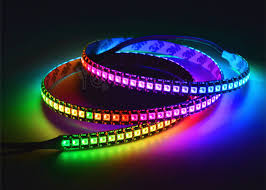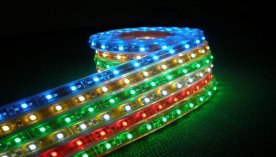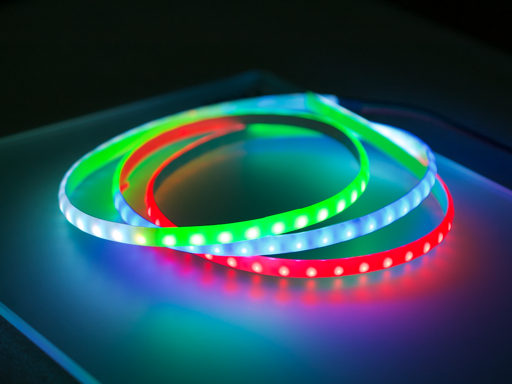RGB LEDs explained. Firstly, RGB stands for Red, Blue, Green, and that configuration can be delivered in one of two ways. Either a triple chip LED or three single chip LEDs, one of each colour all working together. In the case of the 5050 LED, it has three chips inside, -one of each colour. Colour changes occur by adjusting the amount of power sent to each chip.
there are also two types of RGB lighting:
- Digital, Pixel, Addressable LEDs (all the same- just different terminology)
- Analogue
What’s the difference?
In the Digital LED strip, each LED or set of LEDs is connected to a microprocessor. There are traditionally three circuits. A Pos+ power feed wire. A Neg- wire, and a DATA wire. That third line transmits a signal from the control unit to each microprocessor so that the LEDs are controlled individually. Every microprocessor needs a unique address.

Analogue RGB, is when All the LEDs work together as one so while they change colours, there is no ability to switch each chip off and on individually. All the LEDs on strip appear the same colour. The only possessing is down by the controller for all LEDs collectively. There are 4 wires. Each colour is a positive feed, Red, Blue, Green and also a Neg earth wire.

In this article, we are going to focus on the analogue type only. We’ll talk about the addressable strips in the near future.
We’ve all been somewhere where its inconvenient to get up to switch the lights off, or you’ve wanted the change the lighting. From a bright white in the kitchen when cooking to mood lighting while you eat?
Remote Controlled LEDs – RGB work with only a touch of a finger through a variety of control gear.
You can purchase 240V AC LEDs, but they are subject to damage if the national power grid is unstable, and need to be installed by an electrician so they haven’t taken off. We stock 12V DC as it has become the industry standard, just like VHS did over Beta when Video players hit the market.
Then there are:
Wall mounted, hard wired Controllers, just like a traditional light switch, but more complex workings (usually wired inline)
Infrared (IR) controlled – You need line of sight between the remote and control units
Radio Frequency (RF) controlled – These work without line of sight, and are only restricted by distance and baffling. These units can be locked (so that only one remote /controller work as a set, or open so that one remote can communicate with multiple controllers.
Blue tooth and WIFI – They work through you smart phone or computer and the software is downloaded from the internet. Using the homes WIFI, or directly through blue tooth, these systems can facilitate programming a variety of functions like on/off times, brightness, colour changes etc. They can even be set to music.
We supply all but the IR units, which we don’t have a market for.
Its now possible to run RGB lighting in more than one room, and have each room individually controlled with the same controller. We stock Control gear allowing 4 different zones to be controlled.
Benefits of Using Remote Controlled LEDs
Perfect Decoration for Indoor and outdoor : LEDs with remote control facilities are perfect for decorating your house, buildings, offices, shop window, shopping malls, wedding, anniversaries, parties, Christmas and to light other celebratory moods.
Multicolour changing lights : Remote Controlled LEDs give the users the privilege to experience unlimited different color variations. You can easily keep changing the atmosphere from clean, simple, romantic, sweet to disco, and music.
Safe and Efficient : Our 12V DC LEDs are completely safe, and they are extremely energy efficient. They do not get overheated after prolonged use and you can touch the LEDs even after extended usage. The timer / remote functionalities allows you to manage the lights easily. They have long life spans 30-50,000 hrs can be expected from ours. We market LEDs in a large array of configurations so talk to us about your specific use, so we can provide solid advice you can rely on. Ph 07 5564 9930 or email us at: sales@sasign.com.au
